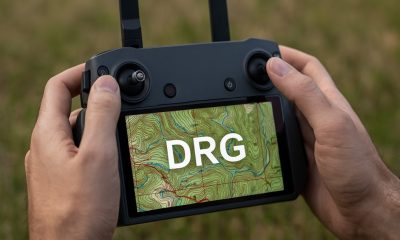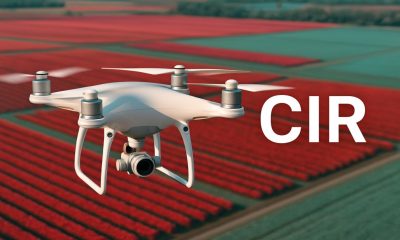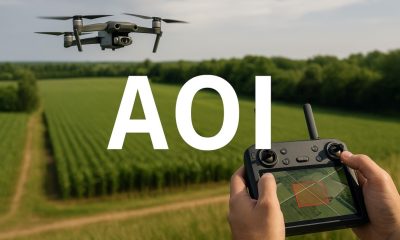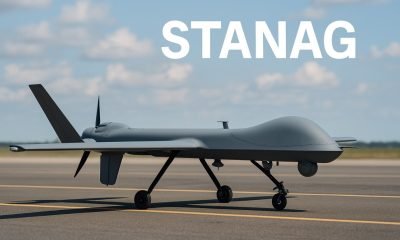- Guide
- Flight in High Winds
- How to Choose Your First Drone
- How to Fly a Drone for Beginners
- Insurance Guide
- Maximize Performance
- Maintenance Tips
- Optimize Flight Time
- Optimize Payload Capacity
- Part 107 & RPAS How to Guide
- Understanding Drone Terminology
- Understanding FAA Drone Regulations
- Safety Guidelines
- Surveying Guide
Top Guides
Drone Pilot License- Part 107 & RPAS How to Guide
By
Jacob StonerTable Of Contents

Fly smart and stay safe out there! Just getting your drone pilot license? Discover free resources to learn the basics here. Ready to earn your FAA commercial drone certificate or your advanced pilot license? Start preparing today right here.
How to Obtain a Drone Pilot License- What You Need to Know?
Have you ever imagined the freedom and excitement of flying a drone for more than just fun? Whether you’re eyeing a professional career in aerial photography, surveying, or emergency response—or simply want to explore drone piloting as a serious hobby—getting the proper license is the critical first step.
Drone technology has soared in popularity, opening up skies filled with opportunity for enthusiasts and professionals alike. However, with great opportunities come responsibilities. To ensure safe, ethical, and legal operation, governing bodies like the Federal Aviation Administration (FAA) in the United States and Transport Canada for Canadian RPAS (Remotely Piloted Aircraft Systems) have established licensing systems tailored to different levels of expertise and drone use.
This guide will take you through everything you need to know about obtaining a drone pilot license. We’ll break down the requirements, explain how to navigate the licensing process, and provide expert tips to make the journey easier. Whether you’re in the U.S. pursuing the FAA’s Part 107 Certification or in Canada working toward your RPAS Basic or Advanced Operations Certificate, this article will give you the tools and knowledge to succeed.
By the end of this guide, you’ll have a clear roadmap to becoming a certified drone pilot, as well as an understanding of the limits and benefits each license offers. Ready to take off? Let’s get started!
Article Guide
- Understanding Drone Pilot Licenses
- FAA Drone Pilot License (U.S.)
- RPAS Drone Pilot License (Canada)
- Comparison of FAA and RPAS Licenses
- Expert Advice for Aspiring Pilots
- Resources to Boost Success
- Conclusion
Understanding Drone Pilot Licenses
Drone pilot licenses are the foundation for safe, legal, and responsible drone operation, whether you’re flying for fun or pursuing a professional career. These certifications are designed to ensure that pilots understand the rules of the air, safety protocols, and the technical capabilities of their drones. With drones becoming more integrated into industries like photography, agriculture, and emergency response, proper licensing is no longer optional—it’s a necessity.
Governed by specific regulatory bodies, the process for obtaining a drone pilot license varies based on where you operate. In the United States, the Federal Aviation Administration (FAA) oversees drone pilot certifications, while Canada’s Transport Canada manages the Remotely Piloted Aircraft Systems (RPAS) licensing program. Both systems aim to balance innovation and accessibility with the need to maintain airspace safety.
A drone pilot license provides more than just legal permission to fly. It equips pilots with knowledge about airspace classifications, weather conditions, and emergency procedures. Licensed pilots also enjoy benefits like access to restricted airspace and opportunities for commercial operations, paving the way for careers in fields like surveying, inspections, and delivery.
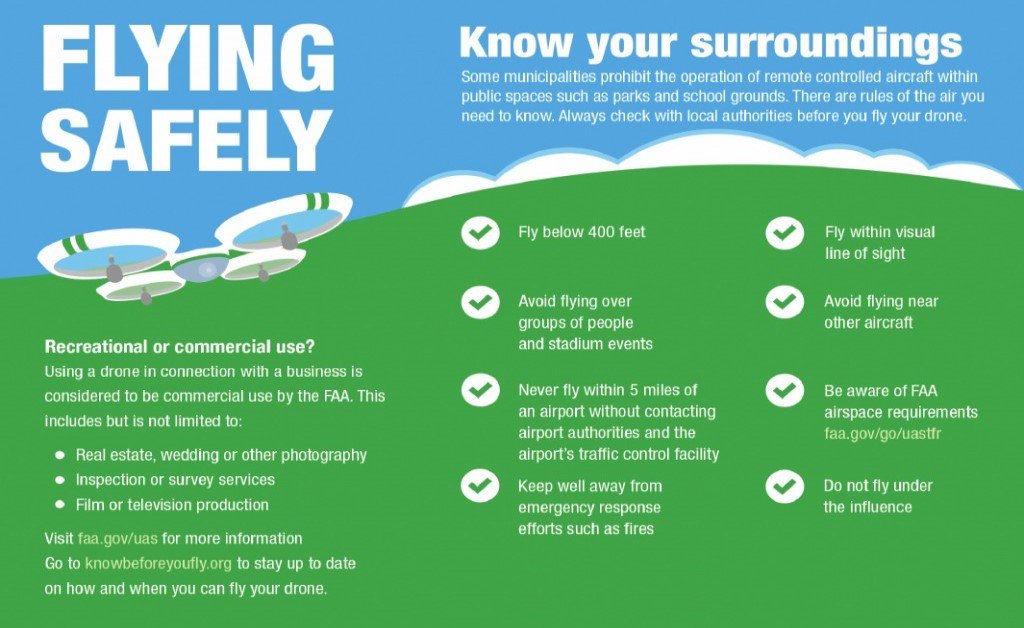
In this guide, we’ll take an in-depth look at the two main licensing systems—FAA for U.S. pilots and RPAS for Canadian pilots—to help you understand the requirements, processes, and opportunities associated with becoming a certified drone pilot.
FAA Drone Pilot License (U.S.)
The FAA Drone Pilot License, officially known as the Remote Pilot Certificate, is required for anyone intending to operate a drone for commercial purposes or in environments that exceed the scope of recreational flying. The FAA provides a clear pathway for aspiring drone pilots, ensuring they have the skills and knowledge to operate safely within U.S. airspace.
License Types
The FAA distinguishes between two main categories of drone pilots: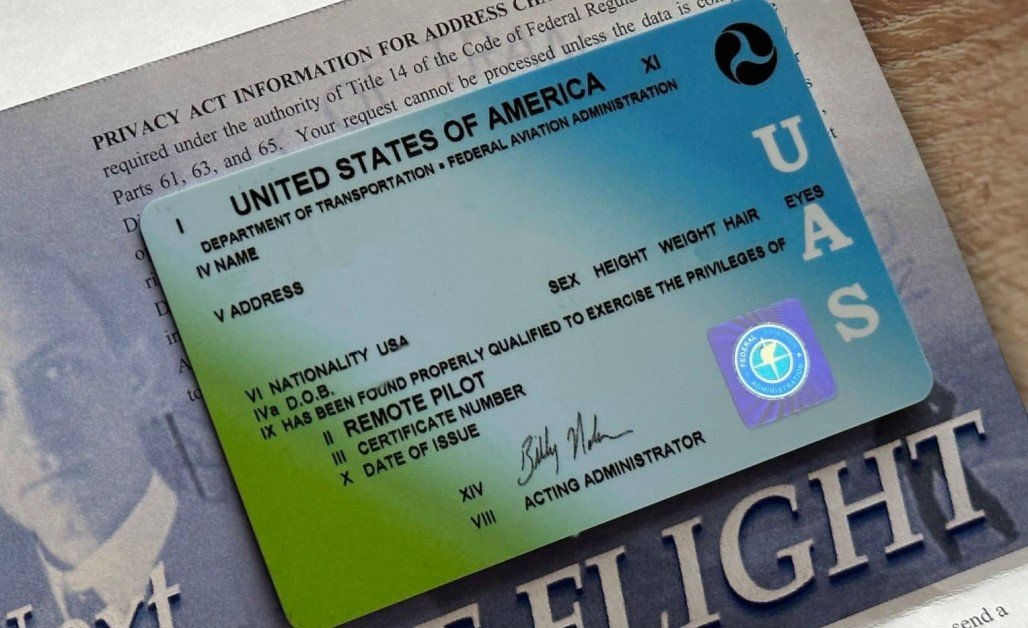
- Part 107 Certification: For commercial pilots or anyone conducting non-recreational drone operations. This certification allows for operations like aerial photography, inspections, and surveying.
- Recreational Flyers (TRUST Certificate): Required for hobbyists. While less rigorous than Part 107, recreational flyers must complete The Recreational UAS Safety Test (TRUST) to understand airspace rules and safety measures.

Requirements
To qualify for the Part 107 Remote Pilot Certificate, you must:
- Be at least 16 years old.
- Hold a valid government-issued photo ID.
- Pass the FAA’s Aeronautical Knowledge Test, which evaluates understanding of airspace regulations, weather, and drone operations.
For the TRUST Certificate, recreational flyers must:
- Complete the TRUST test online through an FAA-approved provider (free of charge).
The Process to Obtain a Part 107 License
- Study the Material: Use the FAA’s resources, including their study guide and sample questions, or opt for third-party training programs.
- Register for the Knowledge Test: Schedule the Aeronautical Knowledge Test at an FAA-approved testing center.
- Take the Test: The exam includes 60 multiple-choice questions, with topics such as weather, airspace classifications, emergency procedures, and drone maintenance.
- Receive Your Certificate: Upon passing the test, complete the FAA’s online application process through the Integrated Airman Certification and Rating Application (IACRA) website to receive your Remote Pilot Certificate.
Helpful Tips
- Leverage Online Courses: Many third-party platforms offer structured courses tailored to the Part 107 exam, complete with practice tests.
- Use Apps for Practice: Apps like Drone Pilot Ground School simulate real exam conditions and help you identify areas to improve.
- Stay Current on Regulations: The FAA updates rules frequently. Ensure you’re familiar with the latest guidelines to avoid surprises on the exam.
Limits of the License
- Drone Weight: Restricted to drones weighing less than 55 pounds, including payload.
- Airspace Operations: Part 107 limits drone flights to Class G airspace unless prior FAA authorization is obtained.
- Operational Restrictions: Flights must be conducted within the visual line of sight (VLOS) of the operator, during daylight or civil twilight hours.
- Recurrent Testing: Pilots must renew their certification every 24 months by completing a recurrent knowledge test.
FAA Drone Pilot License practice exams

To enhance your preparation for the FAA Part 107 Aeronautical Knowledge Test, utilizing free online practice exams can be highly beneficial. These resources provide a realistic understanding of the test format and help identify areas where further study is needed. Here are some reputable platforms offering free practice exams:
- TestBeach: Offers a comprehensive 46-question practice test that mirrors the structure of the actual Part 107 exam.
- Career Employer: Provides over 180 updated practice questions, covering various topics pertinent to the Part 107 test.
- Drone Launch Academy: Features 21 practice questions accompanied by detailed explanations, focusing on commonly tested areas.
- King Schools: Offers a free practice test with answer explanations for the initial question, with additional resources available for purchase.
- Pilot Institute: Provides a 25-question practice exam with explanations, designed to simulate the actual test environment.
The FAA’s Part 107 certification unlocks a world of opportunities for drone pilots, from real estate photography to advanced surveying. For those seeking to fly recreationally, the TRUST test provides an easy way to get started while ensuring safety and compliance.
RPAS Drone Pilot License (Canada)
In Canada, drone pilots are regulated by Transport Canada under the Remotely Piloted Aircraft Systems (RPAS) framework. Whether flying recreationally or for professional purposes, pilots must meet specific requirements to operate legally. Canada’s licensing system emphasizes safety, airspace management, and operator responsibility, ensuring that drones are used effectively and without risk to people or property.
License Types
Transport Canada offers two distinct RPAS certifications, tailored to the complexity and risk of your operations:
- Basic Operations Certificate: Suitable for low-risk environments where drones are flown away from bystanders and outside controlled airspace.
- Advanced Operations Certificate: Required for operations in controlled airspace, near bystanders, or complex settings such as urban environments.

Requirements
To qualify for an RPAS license, pilots must meet the following criteria:
- Age: At least 14 years old for Basic operations and 16 years old for Advanced operations.
- Drone Registration: Drones weighing between 250g and 25kg must be registered with Transport Canada, and the registration number must be clearly displayed on the drone.
- Knowledge Exam: Pass the online Transport Canada knowledge test for Basic or Advanced certification.
- Flight Review (Advanced only): Successfully complete an in-person flight review to demonstrate proficiency in operating a drone.
The Process to Obtain an RPAS License
- Register Your Drone:
- Visit the Transport Canada website to register your drone. You’ll need the make, model, serial number, and a $5 CAD registration fee.
- Display the registration number visibly on your drone.
- Prepare for the Knowledge Exam:
- Study Transport Canada’s TP 15263 Knowledge Requirements for Pilots of Remotely Piloted Aircraft Systems (VLOS) guide.
- Focus on areas like Canadian Aviation Regulations (CARs), airspace classifications, and emergency procedures.
- Take the Online Knowledge Exam:
- Access the exam through the Transport Canada Drone Management Portal.
- The exam consists of 50 multiple-choice questions with a passing grade of 65%.
- Advanced Certificate Applicants Only – Complete a Flight Review:
- Schedule a flight review with an authorized reviewer.
- Demonstrate practical skills, including pre-flight inspections, airspace awareness, and safe flight operations.
- Receive Your Certificate:
- Upon successful completion, download your certificate from the Drone Management Portal.

Helpful Tips
- Use Online Training Resources: Platforms like Sugu Drone School and Transport Canada’s official resources provide structured courses and mock exams.
- Practice Flight Skills: Before your flight review, practice basic maneuvers and emergency procedures in a controlled environment.
- Understand Airspace Regulations: Familiarize yourself with Canada’s airspace classifications using tools like the NAV CANADA Drone Site Selection Tool.
Limits of the License
- Basic Certificate:
- Cannot fly closer than 30 meters horizontally to bystanders.
- Restricted from flying in controlled airspace.
- Advanced Certificate:
- Allows operations in controlled airspace and near bystanders, subject to conditions.
- Pilots must comply with additional safety measures, including the use of RPAS compliant with Transport Canada standards.
The RPAS certification system provides Canadian pilots with clear pathways to operate drones safely and effectively. Whether you’re capturing breathtaking landscapes or conducting professional inspections, these certifications ensure compliance and peace of mind.
RPAS Drone Pilot License practice exams

To effectively prepare for Transport Canada’s RPAS (Remotely Piloted Aircraft Systems) certification exams, utilizing free online practice tests can be invaluable. These resources help familiarize you with the exam format and identify areas requiring further study. Here are some reputable platforms offering free practice exams:
- RPAS Centre: Offers a comprehensive Basic Certificate Exam Preparation Course with video lessons, quizzes, and a mock exam, designed to equip candidates with the necessary knowledge to pass the Basic Pilot Certificate exam.
- AUAV: Provides a realistic exam simulator for both Basic and Advanced RPAS exams, replicating the actual exam experience with timed conditions and a diverse question pool.
- Drone Exam Canada: Features practice tests for both Basic and Advanced exams, with questions categorized by topic to aid focused study. Note that these practice tests are intended for use after achieving a minimum score on their training modules.
- Quizlet: Offers a set of flashcards specifically designed for the RPAS Advanced Operations exam, covering key concepts and terminology.
- TheCountersteerer’s Free Detailed Study Guide: Provides a comprehensive study guide compiling detailed references and knowledge essential for the Transport Canada Small RPA exams.
Comparison of FAA and RPAS Licenses
While the FAA (United States) and RPAS (Canada) licensing systems share a common goal of promoting safe and responsible drone operations, they differ in terms of requirements, processes, and operational limits. Understanding these distinctions is crucial, especially for drone pilots operating near or across the U.S.-Canada border or seeking dual certification.
Key Similarities
- Regulatory Oversight: Both systems are governed by federal authorities—FAA in the U.S. and Transport Canada in Canada—focused on airspace safety and operator accountability.
- Knowledge Exams: Each system requires pilots to pass a test demonstrating proficiency in airspace regulations, safety protocols, and weather considerations.
- Renewals and Updates: Both certifications involve ongoing compliance, such as recurrent testing for FAA pilots and renewal requirements for Canadian Advanced Operations Certificate holders.
- Drone Registration: Pilots in both countries must register drones above a certain weight (250g in Canada and similar in the U.S.) with their respective regulatory bodies.
Key Differences
- Age Requirements:
- FAA: A Part 107 Remote Pilot Certificate requires applicants to be at least 16 years old. Recreational flyers must take the TRUST test, which has no age minimum.
- RPAS: Basic Operations certification requires pilots to be at least 14 years old, while Advanced Operations certification raises the minimum age to 16.
- Certification Types:
- FAA: Distinguishes between recreational flyers (TRUST) and commercial operators (Part 107).
- RPAS: Offers Basic and Advanced certificates, with Advanced operations permitting more complex activities such as flying in controlled airspace and near bystanders.
- Knowledge Exam Format:
- FAA: The Part 107 exam is administered in-person at an FAA-approved testing center, costs approximately $175 USD, and comprises 60 multiple-choice questions.
- RPAS: Both Basic and Advanced exams are conducted online via Transport Canada’s Drone Management Portal. The Basic exam costs $10 CAD, while the Advanced exam is free. The Advanced certificate also requires an in-person flight review.
- Flight Review:
- FAA: There is no practical flight test for the Part 107 certificate.
- RPAS: Pilots seeking the Advanced Operations Certificate must complete a flight review to demonstrate operational proficiency.
- Operational Limits:
- FAA (Part 107): Pilots must operate within visual line-of-sight (VLOS), avoid flying over people without waivers, and request airspace authorization for controlled zones.
- RPAS (Advanced): Canadian pilots can operate in controlled airspace, closer to bystanders, and conduct more complex missions, provided they meet safety requirements and have the proper certificate.
- Recurrent Training:
- FAA: Part 107 certificate holders must complete a recurrent knowledge test every 24 months.
- RPAS: Transport Canada currently requires pilots to renew their certificates periodically but does not mandate a specific recurrent knowledge test.
- Cost:
- FAA: The Part 107 certification process, including testing and study materials, typically costs $200–$300 USD.
- RPAS: The Canadian system is more affordable, with registration and exam fees totaling approximately $15 CAD for Basic certification.

Cross-Border Considerations
- Pilots intending to operate drones in both countries must adhere to the specific regulations and licensing requirements of each jurisdiction.
- The FAA and Transport Canada do not currently recognize each other’s certifications, meaning dual licensing is necessary for cross-border operations.
- Understanding airspace classifications and restrictions is vital, as they differ significantly between the two countries.
This comparison highlights the importance of choosing the right certification based on where and how you plan to operate. For professional pilots, understanding these distinctions can unlock opportunities on both sides of the border.
10 Best Pieces of Expert Advice for Aspiring Pilots
Becoming a certified drone pilot is a rewarding journey, but it requires careful planning and preparation. To make the process smoother and increase your chances of success, here are some expert tips to guide you along the way:
1. Define Your Goals
Understanding why you want to become a drone pilot can help you choose the right certification and focus your efforts:
- Are you looking to fly drones recreationally or professionally?
- Will you operate in complex environments that require advanced certifications?
- Do you plan to work internationally, necessitating dual certification?
Knowing your end goal will keep you motivated and help you prioritize your study and practice.
2. Build a Strong Knowledge Base
Both FAA and RPAS certifications require pilots to master topics such as airspace classifications, weather patterns, drone maintenance, and emergency procedures. Here’s how to prepare effectively:
- Study Guides: Use official materials like the FAA’s Remote Pilot – Small UAS Study Guide or Transport Canada’s Knowledge Requirements for RPAS.
- Online Courses: Platforms like Pilot Institute, Drone Pilot Ground School, and UAV Ground School offer structured learning paths with video tutorials and practice tests.
- Practice Tests: Take advantage of free online exams to familiarize yourself with the test format and identify weak areas.
3. Invest Time in Hands-On Practice
Practical experience is invaluable, especially for Canadian pilots pursuing the Advanced Operations Certificate, which requires a flight review. Even if a flight test isn’t required for your certification, developing solid flying skills will:
- Boost your confidence during operations.
- Prepare you for real-world challenges like adverse weather or emergency scenarios.
- Familiarize you with your drone’s controls and features.
Start with basic maneuvers, then gradually introduce more complex exercises like obstacle navigation or filming smooth tracking shots.
4. Leverage Flight Simulators
For new pilots, flight simulators provide a safe and cost-effective way to practice without risking your drone. Many simulators mimic real-world physics and environments, helping you improve coordination and prepare for real-world operations.
Recommended simulators:
- DJI Flight Simulator: Tailored for DJI drones, offering realistic training scenarios.
- Liftoff: Focused on FPV drones but helpful for mastering control dynamics.
- Zephyr Drone Simulator: Provides structured training programs aligned with FAA and Transport Canada requirements.
5. Stay Updated on Regulations
Drone laws and regulations are constantly evolving. Stay informed by:
- Subscribing to updates from the FAA or Transport Canada.
- Joining drone pilot forums and communities where regulatory changes are often discussed.
- Using tools like the FAA’s B4UFLY app or Transport Canada’s Drone Site Selection Tool to check airspace restrictions before flying.
6. Network with Other Pilots
Joining a community of drone enthusiasts and professionals can provide invaluable insights, support, and resources. Consider:
- Attending local drone meetups or joining flying clubs.
- Participating in online forums like Drone Pilot Ground School’s community or Canadian Drone Pilot Groups.
- Seeking mentorship from experienced pilots who can share tips and best practices.
7. Manage Your Time Effectively
Balancing preparation with other responsibilities can be challenging. Set aside dedicated time for:
- Studying theory and taking practice tests.
- Hands-on practice and simulator training.
- Reviewing regulations and operational scenarios.
Creating a consistent schedule will help you progress steadily without feeling overwhelmed.
8. Prioritize Safety
Safety is at the heart of both FAA and RPAS certification systems. Always:
- Conduct pre-flight inspections to ensure your drone is in optimal condition.
- Develop contingency plans for emergencies like signal loss or battery depletion.
- Respect airspace restrictions and privacy laws to avoid fines and penalties.
9. Don’t Rush the Process
It’s tempting to fast-track certification, but thorough preparation will set you up for long-term success. Take your time to understand concepts, build practical skills, and become a confident, responsible pilot.
10. Seek Continuous Improvement
Once certified, don’t stop learning. Stay engaged with the drone community, explore advanced certifications, and experiment with new technologies to expand your skills and career opportunities.
Resources to Boost Drone Pilot License Success
A variety of resources are available to help aspiring drone pilots prepare for certification exams, enhance their skills, and navigate the requirements of drone operations. Leveraging these tools and materials can significantly improve your chances of success, whether you’re pursuing an FAA Part 107 license in the U.S. or an RPAS certificate in Canada.
Official Study Guides and Manuals
- FAA Remote Pilot – Small UAS Study Guide:
Comprehensive guide provided by the FAA covering all topics tested in the Part 107 exam.
Download here

- Transport Canada’s TP 15263 Knowledge Requirements for RPAS:
The definitive guide for Canadian pilots preparing for the Basic and Advanced certification exams.
Available here

Online Courses
- Pilot Institute:
Offers detailed video lessons, quizzes, and practice exams for the FAA Part 107 license. - Drone Pilot Ground School:
Provides FAA Part 107 training with lifetime access to materials, practice tests, and exam guarantees. - UAV Ground School (Canada):
Tailored for Canadian pilots, this course includes preparation for both Basic and Advanced RPAS certifications.
Mobile Apps
- B4UFLY App (U.S.):
Provided by the FAA, this app helps pilots check airspace restrictions and plan flights safely.
Download - NAV CANADA Drone Site Selection Tool (Canada):
An essential tool for Canadian pilots to check airspace permissions and plan safe flight paths.
Flight Simulators
For practical skills development without risk:
- DJI Flight Simulator:
Offers realistic training scenarios for DJI drone users.
Learn More - Liftoff Simulator:
A versatile tool for practicing FPV and general drone controls. - Zephyr Drone Simulator:
Tailored to educational and certification training.
Community Forums and Networks
- Drone Pilots Central:
Connect with other drone pilots to share experiences, advice, and tips. - Canadian Drone Forum:
A dedicated space for Canadian drone pilots to discuss regulations, certifications, and operations.
Government Resources
- FAA Drone Zone:
Official portal for drone registration, Part 107 application, and airspace authorization.
Website - Transport Canada Drone Management Portal:
Manage drone registration, certifications, and exams in Canada.
Website
Additional Resources
- YouTube Channels:
Channels like Joshua Bardwell, Ready Set Drone, and FlightChops offer valuable tutorials and insights. - Books:
Titles like “Remote Pilot FAA Part 107 Test Prep” and “The Drone Pilot’s Handbook” provide in-depth knowledge for exam preparation.
Drone Pilot License Conclusion
Becoming a certified drone pilot is more than just earning a credential—it’s about joining a growing community of professionals and enthusiasts who are shaping the future of aerial innovation. Whether you’re pursuing the FAA Part 107 Remote Pilot Certificate in the U.S. or the RPAS certification in Canada, the process equips you with essential knowledge, skills, and legal permissions to operate drones responsibly and effectively.
This guide has provided you with a comprehensive roadmap, from understanding the licensing requirements to accessing the best resources for success. Now it’s up to you to take the next step. Dedicate time to studying, practicing, and mastering the fundamentals of drone operations. The investment you make today will open doors to exciting opportunities, whether it’s capturing stunning aerial photography, conducting professional inspections, or innovating within emerging industries like delivery and emergency response.
Remember, your journey doesn’t end with certification. Stay informed about evolving regulations, connect with fellow pilots, and continually seek ways to enhance your skills. The drone industry is dynamic and rapidly expanding, and certified pilots are at the forefront of this evolution.
So, are you ready to take flight? Your adventure as a certified drone pilot awaits, and the sky is truly the limit. Whether you’re in the U.S. or Canada, your journey begins now. Safe flying!
As the CEO of Flyeye.io, Jacob Stoner spearheads the company's operations with his extensive expertise in the drone industry. He is a licensed commercial drone operator in Canada, where he frequently conducts drone inspections. Jacob is a highly respected figure within his local drone community, where he indulges his passion for videography during his leisure time. Above all, Jacob's keen interest lies in the potential societal impact of drone technology advancements.




